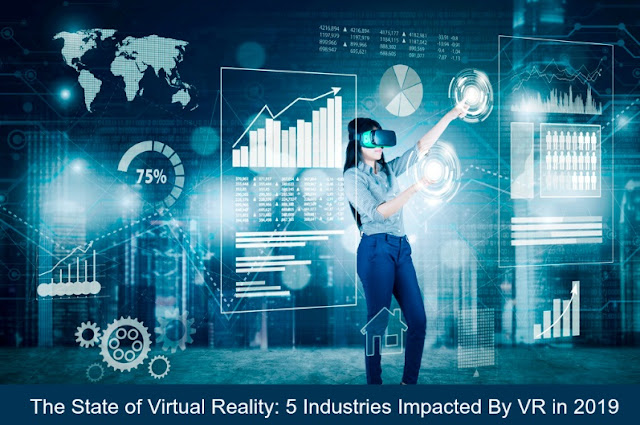The State of Virtual Reality: 5 Industries Impacted By VR
The future looks bright for VR. These immersive technologies represent a new market and opportunities never realized before.
Both consumers and industries are excited for the future of immersive environments, although it should be noted that industries are adopting the technology faster than consumers, towards whom mainly branded content (retail) is being pushed.
Professional and enterprise industries are elevating the position of AR and VR to address the needs of consumers and business users alike. Marketing, tourism, and education are just some examples of industries tapping into the potential of AR and VR.
Here are the top five industries expected to be changed the most by virtual reality technologies.


The State of Virtual Reality: 5 Industries Impacted By VR
1. Advertising VR:
With VR technology gaining popularity across multiple industries, mainstream interest has also rapidly grown. New opportunities have arisen for brands and creators to tap into this yet-to-be-fully-realized lucrative market.
As an immersive storytelling medium, virtual and augmented realities enable brands to create a certain emotional connection with their consumer base. Interacting with an AR and VR advertisement adds depth to the traditional ad experience.
When ads are viewed through a VR headset, several benefits can be enjoyed: images become three-dimensional, landscapes offer an engaging 360-degree view, immersive engagement is established (no distractions), an emotional connection is created (especially for those trying out the headset for the first time), and more.
This becomes a great tool for brands to foster positive associations with their ads, increasing brand awareness and providing a more personalized ad experience.
2. Marketing VR:
Similar to advertising, marketing looks to embrace this innovative technology.
An early adopter of marketing VR has been the New York Times. The New York Times delivered Google Cardboard goggles to its subscribers to use VR technology for visual storytelling. Google Cardboards were delivered to the newspaper’s “most loyal” digital customers.
The disposable VR headset was then used to promote the New York Times’ eighth VR production, “Seeking Pluto’s Frigid Heart.” The intensity of the visuals, coupled with the immersive experience of VR, further reinforced brand loyalty for the newspaper’s digital subscribers.
Brands can integrate VR into their marketing strategy in many ways. As a marketing tool, VR enables brands to allow their customers to get up close and personal with their products and services.
This improves the buyer's journey and accelerates the purchasing process.
3. Travel and Tourism VR:
There’s no question that 20th-century technology has changed the way we travel. The emergence of aviation forever changed the landscape of how people reach their destinations.
Technology continues to define how people travel in the 21st century. Smartphones and other digital technologies further progressed the traditional travel experience. The use of VR technology is set to further eliminate barriers to entry.
Virtual and augmented reality have many applications in the travel and tourism industry.
While VR hardware is not expected to replace the travel experience, it has become a great supplemental tool for travelers.
For younger generations, such as Millennials and Gen Z cohorts, who are happy to spend money if it means gaining a once-in-a-lifetime travel experience, VR enables travel companies to market trendy destinations in an immersive and engaging way.
4. Workplace Training VR:
While virtual reality training is already being used across multiple industries such as military, healthcare, and aviation, expect to see a further uptick in its adoption. Middle-sized businesses and enterprises are now turning to VR to improve their employee on-boarding processes.
An example of enterprises adopting this emerging technology is US-based retailer Walmart. Late in 2018, Walmart rolled out VR training for its associates. VR headsets are set to train Walmart’s employees in three key areas: new technology, compliance, and soft skills.
With VR technology integrated into workplace training programs, corporations can reduce expenses while increasing retention and recall (due to VR’s highly immersive environments). This promotes accelerated learning and reinforces critical aspects of skills development.
5. Educational VR:
Classroom learning is not exempt from the influences of digital technology. Expect VR to play a more prominent role as a classroom learning tool.
Progress has been swift in the VR landscape. Since its emergence, VR’s market share has been on a stratospheric climb. This has reduced barriers to adoption in the educational setting. No longer is VR technology an engagement tool or a gimmick.
Today and further in 2020, the application of VR devices in the classroom facilitates new avenues of learning. They can use VR to supplement and augment a curriculum, catalyzing a student’s curiosity and enabling students to think more critically.
VR technology can also assist students with special needs to further boost engagement and increase classroom participation.
The future of VR:
What was once merely a theme in science fiction has become reality. With a rising number of devices creating hardware and applications to integrate VR technology, expect to see VR offer more functionality across many professions and industries.

No comments